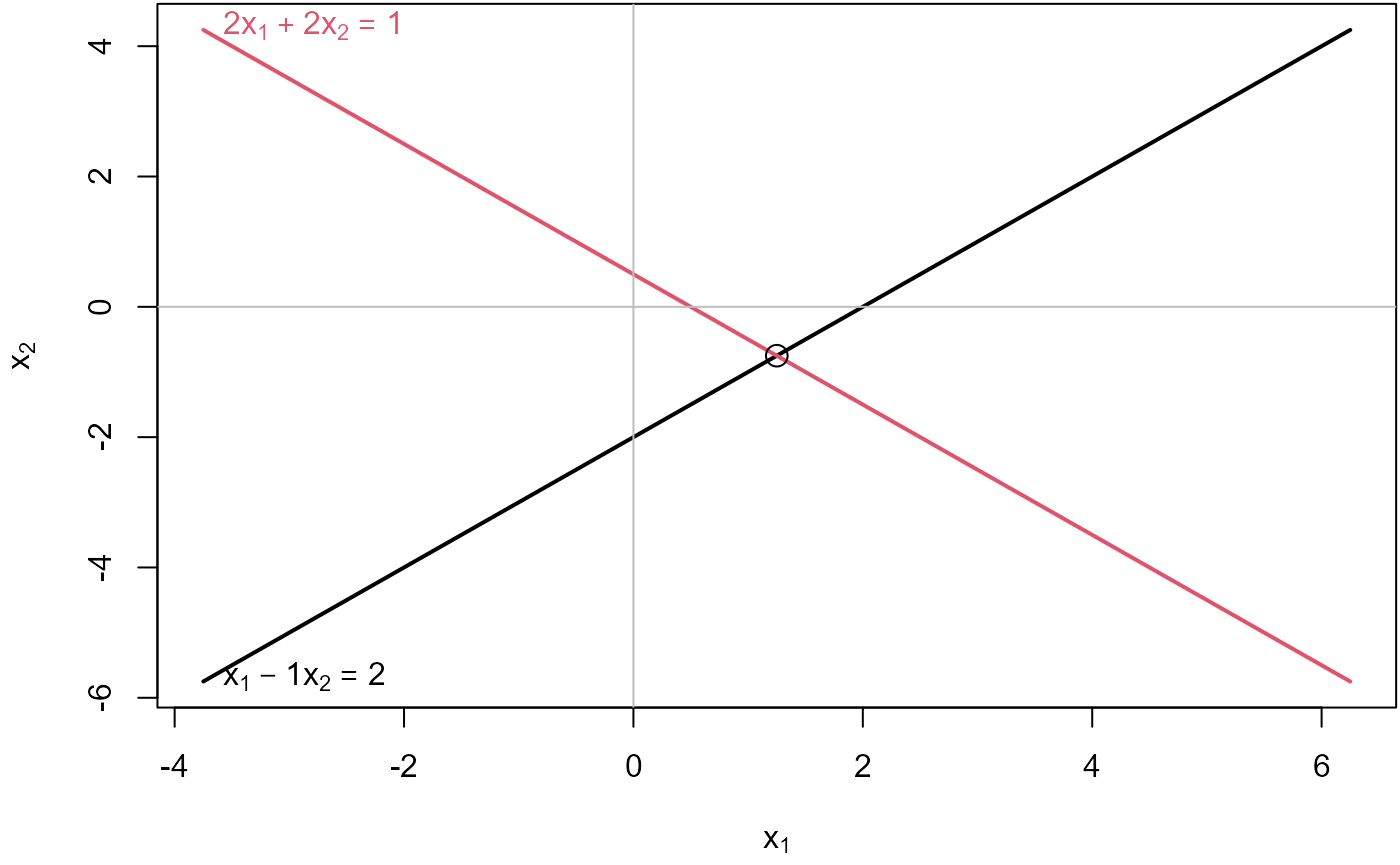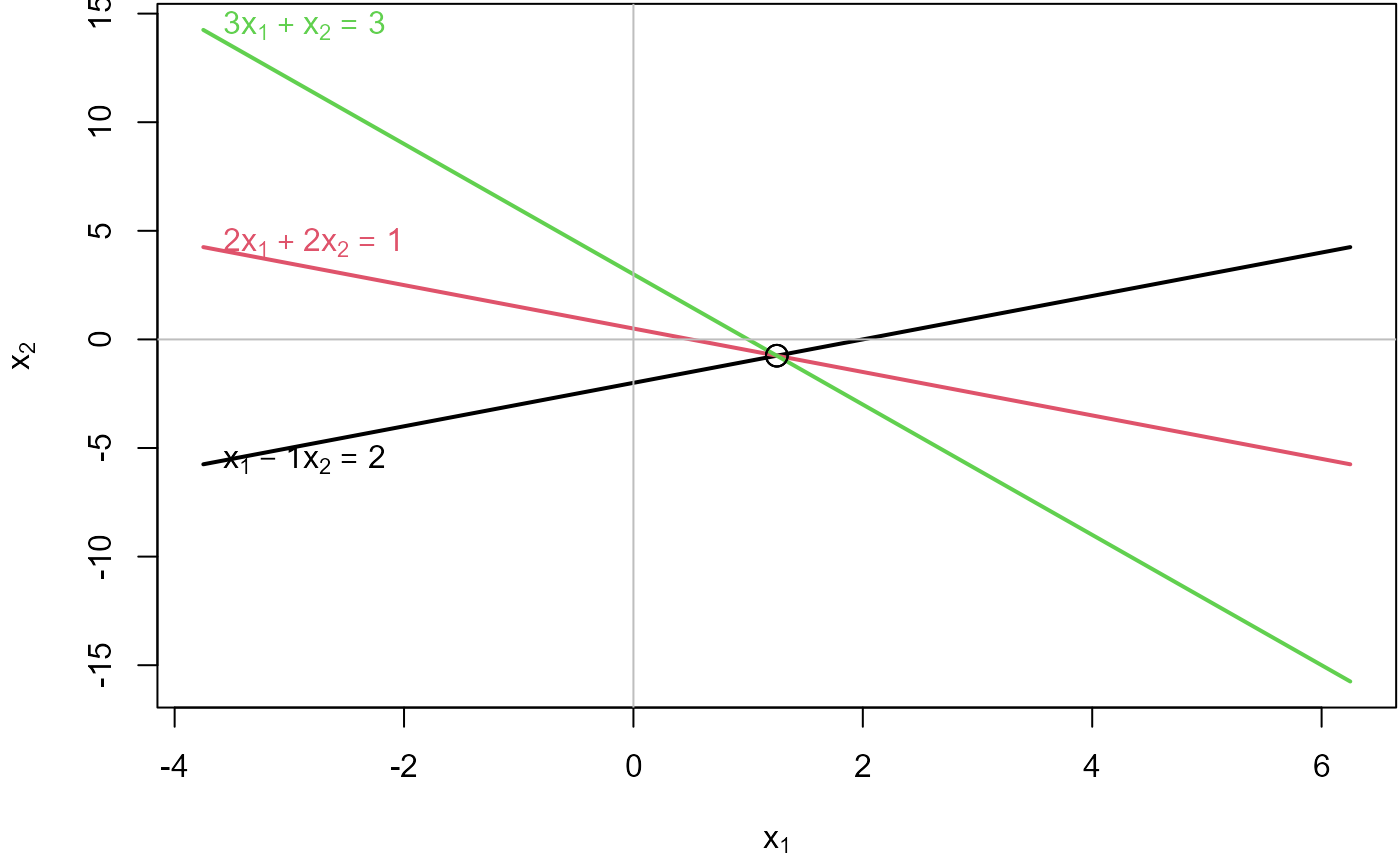9. Solving Linear Equations (original) (raw)
This vignette illustrates the ideas behind solving systems of linear equations of the form𝐀𝐱=𝐛\mathbf{A x = b}where
- 𝐀\mathbf{A}is anm×nm \times nmatrix of coefficients formmequations innnunknowns
- 𝐱\mathbf{x}is ann×1n \times 1vector unknowns,x1,x2,…xnx_1, x_2, \dots x_n
- 𝐛\mathbf{b}is anm×1m \times 1vector of constants, the “right-hand sides” of the equations
or, spelled out,
[a11a12⋯a1na21a22⋯a2n⋮⋮⋮am1am2⋯amn](x1x2⋮xn)=(b1b2⋮bm)\begin{bmatrix} a_{11} & a_{12} & \cdots & a_{1n} \\ a_{21} & a_{22} & \cdots & a_{2n} \\ \vdots & \vdots & & \vdots \\ a_{m1} & a_{m2} & \cdots & a_{mn} \\ \end{bmatrix} \begin{pmatrix} x_{1} \\ x_{2} \\ \vdots \\ x_{n} \\ \end{pmatrix} \quad=\quad \begin{pmatrix} b_{1} \\ b_{2} \\ \vdots \\ b_{m} \\ \end{pmatrix} For three equations in three unknowns, the equations look like this:
A <- matrix(paste0("a_{", outer(1:3, 1:3, FUN = paste0), "}"),
nrow=3)
b <- paste0("b_", 1:3)
x <- paste0("x", 1:3)
showEqn(A, b, vars = x, latex=TRUE)a11⋅x1+a12⋅x2+a13⋅x3=b1a21⋅x1+a22⋅x2+a23⋅x3=b2a31⋅x1+a32⋅x2+a33⋅x3=b3\begin{array}{lllllll} a_{11} \cdot x_1 &+& a_{12} \cdot x_2 &+& a_{13} \cdot x_3 &=& b_1 \\ a_{21} \cdot x_1 &+& a_{22} \cdot x_2 &+& a_{23} \cdot x_3 &=& b_2 \\ a_{31} \cdot x_1 &+& a_{32} \cdot x_2 &+& a_{33} \cdot x_3 &=& b_3 \\ \end{array}
Conditions for a solution
The general conditions for solutions are:
- the equations are consistent (solutions exist) ifr(𝐀|𝐛)=r(𝐀)r( \mathbf{A} | \mathbf{b}) = r( \mathbf{A})
- the solution is unique ifr(𝐀|𝐛)=r(𝐀)=nr( \mathbf{A} | \mathbf{b}) = r( \mathbf{A}) = n
- the solution is underdetermined ifr(𝐀|𝐛)=r(𝐀)<nr( \mathbf{A} | \mathbf{b}) = r( \mathbf{A}) < n
- the equations are inconsistent (no solutions) ifr(𝐀|𝐛)>r(𝐀)r( \mathbf{A} | \mathbf{b}) > r( \mathbf{A})
We use c( R(A), R(cbind(A,b)) ) to show the ranks, andall.equal( R(A), R(cbind(A,b)) ) to test for consistency.
Equations in two unknowns
Each equation in two unknowns corresponds to a line in 2D space. The equations have a unique solution if all lines intersect in a point.
Two consistent equations
## 1*x1 - 1*x2 = 2
## 2*x1 + 2*x2 = 1Check whether they are consistent:
## [1] 2 2## [1] TRUEPlot the equations:
## x[1] - 1*x[2] = 2
## 2*x[1] + 2*x[2] = 1
[Solve()](../reference/Solve.html) is a convenience function that shows the solution in a more comprehensible form:
Solve(A, b, fractions = TRUE)## x1 = 5/4
## x2 = -3/4Three consistent equations
For three (or more) equations in two unknowns,r(𝐀)≤2r(\mathbf{A}) \le 2, becauser(𝐀)≤min(m,n)r(\mathbf{A}) \le \min(m,n). The equations will be consistent if r(𝐀)=r(𝐀|𝐛)r(\mathbf{A}) = r(\mathbf{A | b}). This means that whatever linear relations exist among the rows of𝐀\mathbf{A}are the same as those among the elements of𝐛\mathbf{b}.
Geometrically, this means that all three lines intersect in a point.
A <- matrix(c(1,2,3, -1, 2, 1), 3, 2)
b <- c(2,1,3)
showEqn(A, b)## 1*x1 - 1*x2 = 2
## 2*x1 + 2*x2 = 1
## 3*x1 + 1*x2 = 3## [1] 2 2## [1] TRUESolve(A, b, fractions=TRUE) # show solution ## x1 = 5/4
## x2 = -3/4
## 0 = 0Plot the equations:
## x[1] - 1*x[2] = 2
## 2*x[1] + 2*x[2] = 1
## 3*x[1] + x[2] = 3
Three inconsistent equations
Three equations in two unknowns are inconsistent whenr(𝐀)<r(𝐀|𝐛)r(\mathbf{A}) < r(\mathbf{A | b}).
A <- matrix(c(1,2,3, -1, 2, 1), 3, 2)
b <- c(2,1,6)
showEqn(A, b)## 1*x1 - 1*x2 = 2
## 2*x1 + 2*x2 = 1
## 3*x1 + 1*x2 = 6## [1] 2 3## [1] "Mean relative difference: 0.5"You can see this in the result of reducing𝐀|𝐛\mathbf{A} | \mathbf{b}to echelon form, where the last row indicates the inconsistency because it represents the equation0x1+0x2=−30 x_1 + 0 x_2 = -3.
## [,1] [,2] [,3]
## [1,] 1 0 2.75
## [2,] 0 1 -2.25
## [3,] 0 0 -3.00[Solve()](../reference/Solve.html) shows this more explicitly, using fractions where possible:
Solve(A, b, fractions=TRUE)## x1 = 11/4
## x2 = -9/4
## 0 = -3An approximate solution is sometimes available using a generalized inverse. This gives𝐱=(2,−1)\mathbf{x} = (2, -1)as a best close solution.
## [,1]
## [1,] 2
## [2,] -1Plot the equations. You can see that each pair of equations has a solution, but all three do not have a common, consistent solution.
## x[1] - 1*x[2] = 2
## 2*x[1] + 2*x[2] = 1
## 3*x[1] + x[2] = 6# add the ginv() solution
points(x[1], x[2], pch=15)
Equations in three unknowns
Each equation in three unknowns corresponds to a plane in 3D space. The equations have a unique solution if all planes intersect in a point.
Three consistent equations
An example:
A <- matrix(c(2, 1, -1,
-3, -1, 2,
-2, 1, 2), 3, 3, byrow=TRUE)
colnames(A) <- paste0('x', 1:3)
b <- c(8, -11, -3)
showEqn(A, b)## 2*x1 + 1*x2 - 1*x3 = 8
## -3*x1 - 1*x2 + 2*x3 = -11
## -2*x1 + 1*x2 + 2*x3 = -3Are the equations consistent?
## [1] 3 3## [1] TRUESolve for𝐱\mathbf{x}.
## x1 x2 x3
## 2 3 -1Other ways of solving:
## [,1]
## x1 2
## x2 3
## x3 -1## [,1]
## [1,] 2
## [2,] 3
## [3,] -1Yet another way to see the solution is to reduce𝐀|𝐛\mathbf{A | b}to echelon form. The result of this is the matrix[𝐈|𝐀−𝟏𝐛][\mathbf{I \quad | \quad A^{-1}b}], with the solution in the last column.
## x1 x2 x3
## [1,] 1 0 0 2
## [2,] 0 1 0 3
## [3,] 0 0 1 -1`echelon() can be asked to show the steps, as the row operations necessary to reduce𝐗\mathbf{X}to the identity matrix𝐈\mathbf{I}.
echelon(A, b, verbose=TRUE, fractions=TRUE)##
## Initial matrix:## x1 x2 x3
## [1,] 2 1 -1 8
## [2,] -3 -1 2 -11
## [3,] -2 1 2 -3
##
## row: 1
##
## exchange rows 1 and 2## x1 x2 x3
## [1,] -3 -1 2 -11
## [2,] 2 1 -1 8
## [3,] -2 1 2 -3
##
## multiply row 1 by -1/3## x1 x2 x3
## [1,] 1 1/3 -2/3 11/3
## [2,] 2 1 -1 8
## [3,] -2 1 2 -3
##
## multiply row 1 by 2 and subtract from row 2## x1 x2 x3
## [1,] 1 1/3 -2/3 11/3
## [2,] 0 1/3 1/3 2/3
## [3,] -2 1 2 -3
##
## multiply row 1 by 2 and add to row 3## x1 x2 x3
## [1,] 1 1/3 -2/3 11/3
## [2,] 0 1/3 1/3 2/3
## [3,] 0 5/3 2/3 13/3
##
## row: 2
##
## exchange rows 2 and 3## x1 x2 x3
## [1,] 1 1/3 -2/3 11/3
## [2,] 0 5/3 2/3 13/3
## [3,] 0 1/3 1/3 2/3
##
## multiply row 2 by 3/5## x1 x2 x3
## [1,] 1 1/3 -2/3 11/3
## [2,] 0 1 2/5 13/5
## [3,] 0 1/3 1/3 2/3
##
## multiply row 2 by 1/3 and subtract from row 1## x1 x2 x3
## [1,] 1 0 -4/5 14/5
## [2,] 0 1 2/5 13/5
## [3,] 0 1/3 1/3 2/3
##
## multiply row 2 by 1/3 and subtract from row 3## x1 x2 x3
## [1,] 1 0 -4/5 14/5
## [2,] 0 1 2/5 13/5
## [3,] 0 0 1/5 -1/5
##
## row: 3
##
## multiply row 3 by 5## x1 x2 x3
## [1,] 1 0 -4/5 14/5
## [2,] 0 1 2/5 13/5
## [3,] 0 0 1 -1
##
## multiply row 3 by 4/5 and add to row 1## x1 x2 x3
## [1,] 1 0 0 2
## [2,] 0 1 2/5 13/5
## [3,] 0 0 1 -1
##
## multiply row 3 by 2/5 and subtract from row 2## x1 x2 x3
## [1,] 1 0 0 2
## [2,] 0 1 0 3
## [3,] 0 0 1 -1Now, let’s plot them.
[plotEqn3d()](../reference/plotEqn3d.html) uses rgl for 3D graphics. If you rotate the figure, you’ll see an orientation where all three planes intersect at the solution point,𝐱=(2,3,−1)\mathbf{x} = (2, 3, -1)
Three inconsistent equations
A <- matrix(c(1, 3, 1,
1, -2, -2,
2, 1, -1), 3, 3, byrow=TRUE)
colnames(A) <- paste0('x', 1:3)
b <- c(2, 3, 6)
showEqn(A, b)## 1*x1 + 3*x2 + 1*x3 = 2
## 1*x1 - 2*x2 - 2*x3 = 3
## 2*x1 + 1*x2 - 1*x3 = 6Are the equations consistent? No.
## [1] 2 3## [1] "Mean relative difference: 0.5"